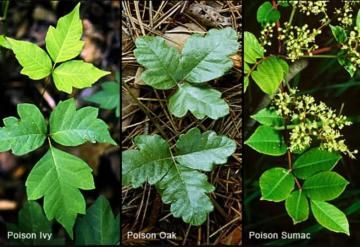Leaves of Three...Leave it Be

We all love to go for a hike or camp amongst the trees. Here are 3 poisonous plants you need to watch out for as they can ruin your day or camping trip and make you very itchy if touched!
#1. Poison Ivy is the most common poisonous plant you’ll encounter while outdoors, and it causes an itchy rash in most people who touch it. The rash is caused by urushiol, a clear liquid compound found in the sap. Despite its common name as an ivy, poison ivy is not a true ivy because it does not always climb. It is variable in its appearance and habitat. It can be found growing as a shrub, a trailing vine along the ground, or a climbing as a vine up fences, posts, and trees. Identify Poison Ivy by: A woody stem (no thorns) with clusters of 3 leaves consisting of 2 opposing leaflets and 1 larger terminal leaf. Each group of three leaflets grows on its own stem, which connects to the main vine. Leaflets may have a notch. Flowers are yellow-green (appearing May – July) in clusters near the round, waxy white berries.
#2. Poison Oak is a low growing shrub (up to 3 ft tall) with compound leaves containing 3 leaflets. Unlike poison ivy, the leaflets are lobed with rounded edges, which give it the appearance of an oak tree leaf. Identify Poison Oak - The “oak” in the common name refers to the fact that the leaves resemble those of the white oak tree. Coincidentally, poison oak tends to climb on the trunk of Oak trees. Leaves are brighter on the top side and slightly hairy underneath. Flowers are yellow-green (appearing May – June) in clusters near the hard waxy berries (berries turn white during autumn).
#3. Poison Sumac - Sumac is a short tree (up to 25 feet) with a few wide spreading branches. It likes water and is usually found in wet soils in and around swamps and marshes. The compound leaves are pinnate, containing an odd number of leaflets, usually between 7-13 in number. Identify Poison Sumac - The leaflets are 2 to 4 inches long with a smooth edge and pointed tip. Because it is a tall, sumac poisoning tends to affects the face and head. The flower and fruit from poison sumac are very similar to those of poison ivy and poison oak.
These plants can cause irritating rashes and blisters and are best avoided at all costs. A good rule of thumb is 'Leaves of Three, Leave it Be'
Also, keep an eye on your dog when hiking. A few minutes of your dog walking off trail to sniff around is all it takes for him/her to brush up against one of these poisonous plants. Dogs are not allergic to the oil and you won’t realize it until later when you cuddle with (or pet) your dog.
Should you accidentally touch one of these plants immediately rinse your skin with cool water right away. Then, wash with soap and water. Rinse your skin well. Do not use hot water because it may cause the oil to spread on your skin.






